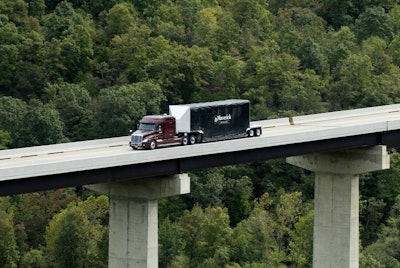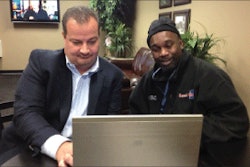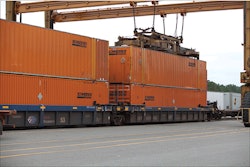 The company’s IT team develops dashboards for virtually every department of its separate business entities so users can get a wider view of the overall enterprise.
The company’s IT team develops dashboards for virtually every department of its separate business entities so users can get a wider view of the overall enterprise.When a company is born, there may not be an easy way to predict its future success. But climbing to the top requires a clear view of the critical steps needed to get there – and stay.
Maverick USA’s roots go back to the Motor Carrier Act of 1980 that deregulated the trucking industry. Steve Williams – who had begun his trucking career five years earlier with Steel Haulers Inc. in Kansas City, Mo. – seized the opportunity to pursue his dream of company ownership and started Maverick with friend and co-worker Larry Leahy in a one-room office in Texarkana, Ark.
In 1983, he purchased his partner’s interest in the company and became the sole owner of Maverick Transportation Inc., and today serves as president and chief executive officer. Today the Williams family still owns 100 percent of the Maverick companies.
The flatbed carrier’s history over the past 30 years has been anchored by “The Maverick Way” – Williams’ principles and values centered around integrity, respect and commitment. Growth has come from reinvestment of earnings in company-owned equipment and five acquisitions: Kissick Truck Lines in 1994, Jewett Scott Truck Line in 2002, Parrett Trucking in 2004, Schneider Specialized in 2006 and Crossover Transportation in 2010.
Maverick Transportation Inc. became Maverick USA Inc. in 2005 and now owns and operates Maverick Transportation, Maverick Logistics and Maverick Leasing, hauling steel, building materials, flat glass and temperature-controlled products. Today, from the corporate campus in Little Rock, Ark., Maverick operates more than 1,400 tractors and provides services throughout the United States, Canada and Mexico.
Measuring up
With separate entities tasked with their own functions and large teams of employees fulfilling many disparate responsibilities at each, a top-notch technology infrastructure was deemed critical to keeping closer tabs on the overall enterprise.
Even small changes to processes in one entity might lead to swings of hundreds of thousands of dollars on the bottom line; changes in routes, driver training, gas mileage and accident rates all affect profits. Maverick also wanted a better way to keep track of routine paperwork such as data from its electronic onboard recorders and renewal dates for commercial driver’s licenses.
Until about five years ago, however, the company couldn’t visualize real-time trends easily or predict future outcomes accurately. “People were running a lot of reports, but not getting real-time information,” says Wayne Brown, vice president of information technology. “They were basing decisions on data that was days or weeks old.”
Maverick’s IT team was tasked with helping the company aggregate all of the data it had to help enhance the company’s business intelligence and support its corporate objectives to drive business value. This goal, however, was not a simple one to achieve.
“One of the complexities we faced is that there’s not one big software company that does everything,” says Brown. “Even companies that have a lot of different offerings have different databases that run those systems.”
Those different formats – especially when they originated from systems provided by different vendors – didn’t always work well together. “We had a lot of separate databases and a lot of great data, but we didn’t have a way to put it together,” he says.
Best in class
Brown joined Maverick nine years ago and says the company always has been “best in class” when it comes to selecting software for its many operating units – but that high-end preference proved to be a double-edged sword.
“We’d bolt on a system to whatever we already had,” he says. “We currently have a hodgepodge of software. Add in all of the complexities of dispatch, safety, operations, maintenance – to get a true view of cost and expenses for the entire company, we needed to get more efficiencies out of the system. We needed true key performance indicators to provide a more holistic view of the company and give people a full view of what they needed to work on.”
The initial goal of Maverick’s IT team was to replace the company’s financial reporting across its multiple operations – a process that took “six to nine months,” Brown says. It then took another three months to build an operations dashboard. But once Maverick employees saw those initial results from the IT team’s first year of work, momentum began building.
“Once people starting getting that data, they had their own ideas for their own dashboards, and they started making requests,” Brown says. Dashboard development became more robust from that point forward.
Maverick has been using the integrated dashboards for about five years now, and now three full-time analysts continue to develop and update new dashboards for virtually every department for functions such as operations, safety, maintenance and financials. The company currently has 50 dashboards that access the same database, providing users with as wide a view of the overall enterprise as necessary.
“It’s been an organic growth, a continual process, something that we continue to augment,” Brown says. “Maverick made a commitment across the organization to the concept of aggregating all of the data we have to help support our corporate objectives. Members on the IT team embraced and implemented the solution from the ground up.”
Making movies
Maverick is no stranger to other technology trends. As part of its growing public relations and marketing efforts, the company has its own in-house video production department – as well as its own corporate YouTube channel.
“The role of our marketing and branding efforts has always been to deliver compelling and useful information about our company, and the transportation industry, to our customers and professional truck drivers,” says Spring Dixon, public relations manager. “Without a doubt, the most powerful medium in which to communicate a message is through video. This adds a whole new element to our marketing efforts.”
Maverick chose to keep video production in-house to closely manage its brand, creative content and message. “Having access to an in-house team is important because we need people who are surrounded by this industry on a day-to-day basis,” says Dixon.
Driver recruiting and sales were the initial primary focuses of video content, followed by several projects in human resources, safety and operations. The fleet films its own in-house safety videos – some as short as 15-second reminders of proper safety procedures – that are beamed out to trucks on the road for drivers to watch at their convenience from their in-cab devices.
“The possibilities are endless,” says Dixon. “One of the distinct advantages of corporate video is that it can be used across several different platforms, from broadcast to social media.”










